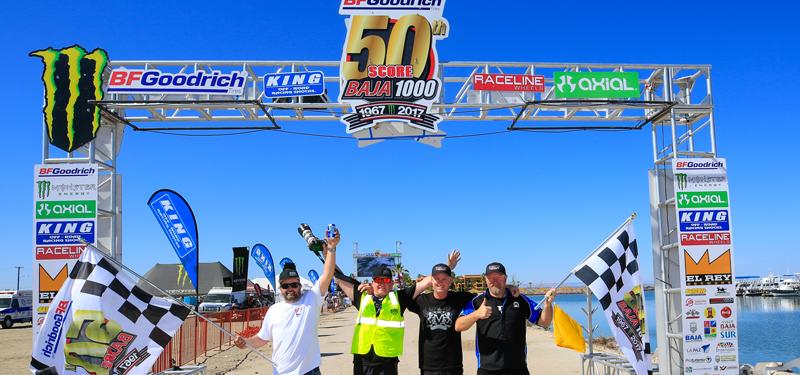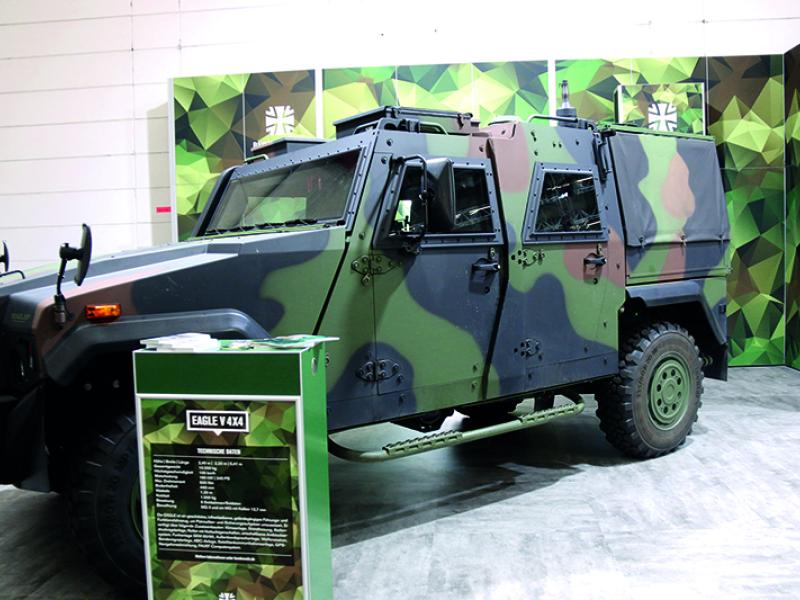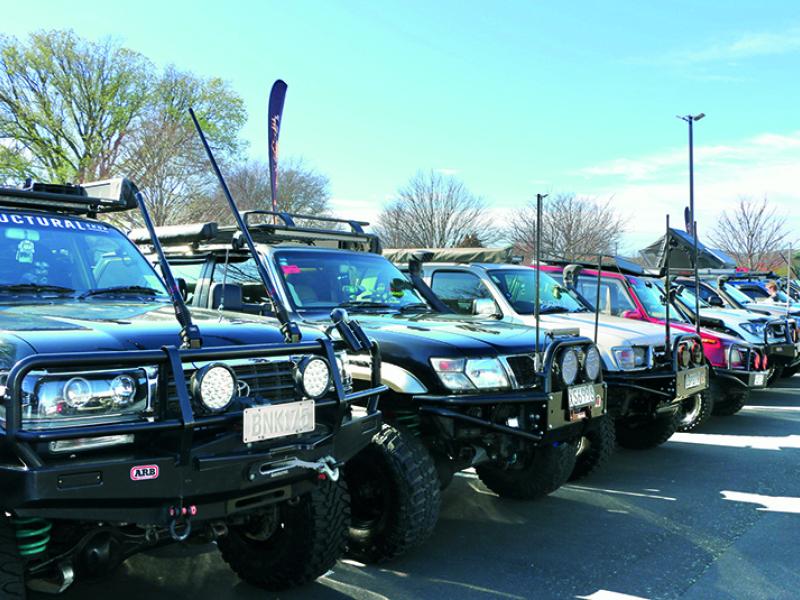Tagging along with a bunch of fellow Kiwis keen Auckland off-road racing photographer Mike Peffers saw the 2017 SCORE Baja 1000 from the inside. Only a few weeks before the latest edition, the 50th Anniversary, in early November last year, I got the chance to join 2016 NZ Race Champion, Mike Fraser who was going for his first time.
He was joining up with Glen Reid who was taking one of his NZ-designed-and-built Futura tilt trailers for some real world testing on the roads of Baja with expat Kiwi Rhys Millen who was running two of his Polaris RZRs in the Pro UTV Forced Induction class (which he had won in 2016).
As well as providing the trailer, we would be joining the support team for the race in chase trucks and setting up remote pits.
Leaving LA for San Diego to pick up the rental car that would be our transport and occasional accommodation in Mexico, we took a small detour east to visit Glamis and see the massive sand dunes used by off roaders for testing and promotional videos. It was the first time for all of us at Glamis, and it provided some new experiences (on which more next month. Ed).
Across the border
Heading south across the border, we met up with Rhys Millen Racing at their race base, some 40km north of Ensenada, where the race would start in four days’ time. They had been out pre running (reconnaissance) the course to map out the hazards, spending two weeks covering every mile of the 1,134 mile (1,825km) course to La Paz in Baja California Sur.
While a lot of the sections of the course are run each year, the track changes every year so the race notes need to be updated on their on-board GPS equipped iPads. Rhys told me that unlike a rally where he notes every corner and brow, due to the length of the race, he notes just the major hazards and sections he can pass, but well enough that he can drive it almost blind with the support of his Kiwi co-driver, Mike Carpenter.
This is vital when you are in the dust cloud created by a racer in front of you and visibility is virtually nil. Due to their class, they would be starting behind a lot of slower cars and would need to get in front of them to get out of their dust to get up to his top race speed of over 100mph (160km/h) on the fast sections.
Joining Rhys in his team was Sabot Racing’s Hammond Meredith who was in an identical, Rhys Millen Racing-prepped Poalris RZR. To support the two race cars, the team had four chase trucks and four pre runner RZRs, plus, of course, our rental and the Futura trailer. They were not here to make up the numbers in the race, with Rhys focused on defending his title.
No pressure then
Two of us Kiwis were split into the chase trucks, one supporting Rhys and the other Hammond. Mike and I were tasked with setting up the remote fuel pit stop in La Purisima. I felt a little apprehensive when Team Chief JR told us that it was the most important pit stop as we would be filling both cars, and not have chase truck support due to the remoteness and difficulty to access it. And to boot, there was no cell phone coverage, instead we would be relying on a portable radio for two-way communication with the car when in range. Because of the distance, we would leave the day before the race started and stay in a town called Loreto on the eastern side of the peninsula, some 1,015km away from Ensenada. From there we could rest before heading out in the middle of the night to set up in La Purisima.
Up close and personal
With two days to go before race start, we headed into Ensenada to get a taste of Contingency, where each competitor drives through the fans to be interviewed at the start line and have the final tech inspection on the car/truck/bike/quad they would be driving. This is a major part of the event, and the chance for the fans to get up close and personal to the racers. Two Kiwis competing in their first race, Phil Casey and Quinn Wilson, said it was a real eye opener, seeing how enamoured the crowd was, treating a couple of ‘nobodies from Queenstown’ like celebrities.
It was a great chance to get into the spirit of the event, talking with the drivers, the fans and the street vendors selling the ubiquitous fish tacos. I met up with Jim Chamberlain who was with Bruce Meyers, showing off a replica of the Meyers Manx that won the first race back in 1967. Jim had built the original one, and had a hand in the replica. Bruce was selling his book on the beginning of the Baja race scene, and was very popular with the fans.
Day before race day, Mike and I had the chance to go pre running with Rhys and Hammond over the first 50 miles (80 km) of the course before driving down to Loreto. The first few hundred miles of the course had only been open for pre running in the last couple of days, so Rhys wanted to make the most of it before the flag dropped the next day.
Leaving the race base, we drove down the main highway in race-specced RZRs in helmets going through the toll gate and through town as if there was nothing out of the ordinary. With plenty of Trophy Trucks and other off-road cars driving around Ensenada, it was ‘ordinary’. Then it was onto the course proper for our first experience of desert racing Baja style, and it was as bumpy and dusty as we had been led to believe, with visibility at a premium. The race start proper would be interesting for the guys the next day with passing spots rare in the first few tight and twisty miles that we drove.
Long drive
Now it was time for Mike and I to drive to Loreto. Leaving at midday, we knew it would be way past midnight before we would arrive, and that we would need to go through a number of army check points to get there. We were warned that the check points like to get souvenirs of the race like T-shirts and stickers while ‘inspecting’ the cars.
As it turned out we went through four of them, of which one relieved us of a couple of team caps, with the others settling for stickers, which we had plenty of. It was all in good humour. We passed numerous chase trucks loaded with fuel and supplies on the highway to Loreto, obviously doing the same thing as us.
After a few hours’ sleep, we took the time to look around Loreto, a magical little town with a lot of local history and where the Jesuits first established a mission on the peninsular in the 1700s. We joined a bunch of local motocross riders for breakfast at a place called Del Rey El Taco, reputedly the best Tacos in the region. And they were.
The race is on
By now, the bike racers had been on the course for 10 hours, having started at midnight, ten hours before the first of the Trophy Trucks. By luck we came across a section of the race track through a dry river valley before crossing onto a public road where the speed restriction was 37mph (60km/h).
With all racers on GPS, race control knows when the speed limit is exceeded, and add time penalties. An interesting note here is that overall winner Carlos Lopez did not get any time penalties, whereas most racers did.
At the dry river valley we met an expat American setting up with his wife and friends to watch the racers come through, and share a few laughs with the local race fans and police. We were lucky enough to see the first three bikes come through before we had to head back and get on the road to La Purisima.
On the road, the first task was to fill the cans that we would use to refuel Rhys and Hammond’s RZRs. US$480 later, we continued towards La Purisima, on a straight 100 mile (160km) road. We faced a couple of challenges, first the fog, dense Waikato-type stuff with visibility down to 20 metres. The other, was the variability in the quality of the road.
One minute we were on a well paved road with a shoulder and decent reflectors, the next, without any warning, the road would almost disappear into a big state of disrepair, testing the suspension on the rental. The fog stayed with us for the whole length of the road, and only dissipated when we dropped into a valley near our destination of La Purisima.
Aussie, Aussie, Aussie
It was hard enough for us on a paved road, we were thinking of those racing through it in the silt beds. Veteran racer, Randy Salmont told me later that it was the worst fog he has experienced since first doing the race in 1979. On a side note, he won Class 8 in 1987 in an Aussie-built Ford Falcon Ute, the only Australian car to win a class at the race.
After passing a section where we could see campfires either side of the race track heading back towards the hills, we arrived into La Purisima, an apparently abandoned town straight out of a Clint Eastwood spaghetti western movie. We were to set up our pits as close to the BFGoodrich pits so the guys would know where we were when they came into radio range. We arrived to see space was at an absolute premium, not something we expected in the desert. With a spot roughly identified, we headed back to where the campfires were to join the fans to watch the Trophy Trucks and cars come through. The first five Trucks had already gone through before we arrived, making good time despite the fog.
Enduring memory
Meeting the fans, sharing stories and a few beers around the campfire while dust rained down on us as the Trucks and cars raced by is will be an endearing memory of the SCORE Baja 1000 for me. It is as much about the local fans as it is about the racers. I got the chance to snap a few of the racers coming across a water crossing, something else I didn’t expect to see in the desert.
Back at our pits at 5am, we took the chance to get a nap before expecting to see Rhys come through for his refuel. As 7 am rolled by the first few UTVs in class passing us over the next hour, but no sign of Rhys. Finally around midday, 10 hours since we had arrived, Hammond’s car arrived. Mike and I would get to finally do our task of filling up one of the cars, which went without a hitch. The guys told us that Rhys’s RZR was out of the race due to an issue in the silt beds. Our job done it was time to pack up and head south towards La Paz.
Local legend
En route, we stopped at a taco joint on the side of the road for some well-earned food. A big bloke called High Tower came up to us, seeing we were Kiwis, to tell us that their clients, Phil Casey and Quinn Wilson were still in the race and somehow were pushing onto La Paz solo.
High Tower is part of Baja Legend ‘Pistol’ Pete Sohren’s Baja Adventures business which rents out Trucks to race. Pete was racing in his own Trophy Truck, but had come awry earlier in the race, and was now focusing on getting Phil and Quinn across the finish line.
We carried on south only to catch up Rhys and his support crew heading towards La Paz and our accommodation for the night. Hammond made it across the finish line sixth in class, 33 hours after he had left Ensenada, a massive result for his first time down there.
Final fix
The next day we were mingling around the finish line to get our last fix of the event, when a yellow Class 3000 car wound its way through the last few corners to complete the race. It was Baja Adventures’ crazy Kiwi clients, Phil Casey and Quinn Wilson. 44 hours and 54 minutes earlier they had left the start at Ensenada on the adventure of a lifetime, crossing the line third in class, doing it solo – Iron Manning it.
Phil had a little experience in rally and stock cars, but co-driver Quinn had no prior motorsport experience, and had only signed up to do the race six weeks before. They had numerous issues on course from blown rims, cactus in the car, blocked radiators, non-stop oil leaks for the last 300 miles 482km), and getting stuck in the notorious silt beds. But they made it, and seeing the New Zealand flag waved proudly over the finish line as the team celebrated was a fitting way to cap of my first experience of the SCORE Baja 1000.
Bucket List Item ticked off. Now to go back and race in it myself!
To read every story in the March 2018 issue of NZ4WD go to Zinio.com (Feb 16) or purchase your own hard copy at the Adrenalin store.






